Corn Use for Ethanol Increased This month
Partly offsetting the increase in domestic corn use is a decline in exports, but total corn use is projected higher. US corn export prospects are reduced on increased competition from Argentina. US ending corn stocks are lowered, and the corn price range is narrowed this month.
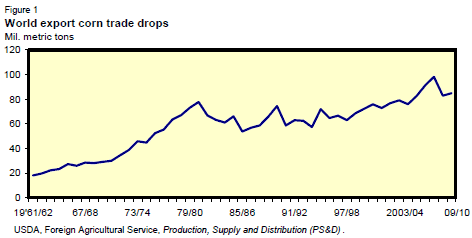
DOMESTIC OUTLOOK
Feed Grains Use Prospects Up in 2009/10
Feed grain supplies for 2009/10 remain unchanged this month at 399.6 million metric tons. Total use of the four feed grains is projected 1.4 million tons higher at 351.1 million this month. This increase is the result of increased corn used for ethanol, and increased sorghum exports, which are partially offset by decreases in corn exports and sweetener use. Feed grain exports for 2009/10 are forecast at 54.8 million tons, down 1 million this month and down 3.6 million from last year. The increase in domestic use lowers ending stocks 1.4 million tons this month to 48.4 million. In 2008/09, ending stocks for the four feed grains totaled 47.0 million tons. Feed and residual use for the four feed grains plus wheat converted to a September- August marketing year is unchanged this month. Grain-consuming animal units are 92.4 million this month, unchanged from last month, based on the 30 January Cattle report. Feed and residual use per animal unit is also unchanged this month at 1.65 tons.
Corn Ethanol Projections Raised This Month
The 2009/10 marketing year corn supply projections are unchanged this month. Corn disappearance is increased because of an increase in ethanol use, offset by a slight decline in corn used for sweeteners and a decline in corn exports. Corn used for ethanol is projected 100 million bushels higher reflecting the latest ethanol production data from the Energy Information Agency. November’s record ethanol production was up 3 per cent from the previous record in October as higher prices for ethanol and distillers’ grains boosted ethanol producer returns. In the first quarter, corn used for fuel represented 27 per cent of total use in the quarter, up from 25 per cent in first quarter 2008/09. Although returns have declined since November, recent lower corn prices continue to support profitability for ethanol producers. Use of corn in sweeteners and starch during the first quarter of 2009/10 is down from the previous quarter and first quarter 2008/09. A 5-million-bushel reduction in expected corn use for sweeteners partly offsets the increase for ethanol. Sweetener and starch use for the first quarter accounted for 6 per cent of total corn use, down just slightly from the same quarter in 2008/09. First quarter exports are 12 per cent of total use, unchanged from 2008/09. Corn exports for 2009/10 are projected 50 million bushels lower on increased competition from Argentina. The projected range for prices received by farmers in 2009/10 is narrowed 5 cents on each end of the range to $3.45 to $3.95 per bushel.
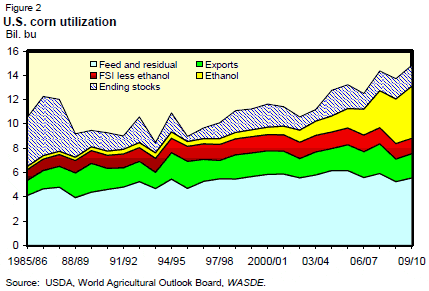
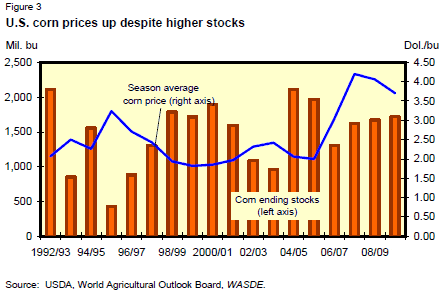
Sorghum Use Prospects Increase in 2009/10
The 2009/10 sorghum supply forecast is unchanged this month. FSI and feed and residual use is also unchanged this month. Forecast sorghum exports are increased 10 million bushels to 150 million in 2009/10. Projected ending stocks are lowered to 48 million bushels, down 10 million from last month.
First quarter 2009/10 sorghum exports were 46.2 million bushels, up from 44.2 million in first quarter 2008/09. Exports were 18 per cent of total use in first quarter 2009/10, up from 15 per cent in the same period in 2008/09. The projected range of prices received by farmers in 2009/10 is narrowed 5 cents on each end to $3.10 to $3.50 per bushel.
Barley and Oats Forecasts Unchanged
Barley and Oats supply and use forecasts are unchanged this month, but barley prices were narrowed 5 cents this month. Barley prices received by farmers are expected to range from $4.25 to $4.55 per bushel. Oats prices are forecast to range from $2.00 to $2.20 per bushel.
Hay Price Prospects in 2008/09 Remain High
As reported last month, hay stocks totaled 107 million tons on 1 December 2009, up 3 per cent from a year ago. In addition, the annual cattle inventory was released since the last Feed Outlook report. Cows and heifers that calved on 1 January 2009, were down 1 per cent from the previous year, and replacement heifers were down 2 per cent. Recalculated roughage-consuming animal units (RCAU) in 2009/10 are projected to be 70.3 million units, down 1 per cent from 2008/09. Hay stocks per RCAU are projected to be 1.525 tons in 2009/10, up from 1.462 tons a year earlier. All hay prices for the 2009/10 marketing year have averaged less than a year ago. All hay prices for May 2009-January 2010 averaged $112.67 per ton, down from $155.56 per ton in the same period a year earlier. Prices received for alfalfa hay in May 2009-January 2010 averaged $116.44 per ton, down from $168.89 a year earlier. During May 2009-January 2010, other hay prices averaged $102.23 per ton, up from $119.22 per ton last year.
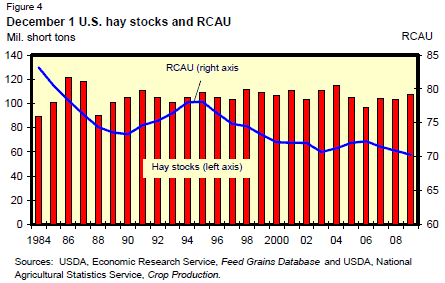
INTERNATIONAL OUTLOOK
World Coarse Grain Production Projected Up This Month
Global coarse grain production for 2009/10 is forecast up 1.6 million tons to 1,095.5 million. The increase is driven by corn in Argentina, up 2.2 million tons to 17.2 million. Prospects for area and yield have increased due to favorable rains in key corn-growing areas of Santa Fe; north, central, and eastern Buenos Aires; and parts of Cordoba. Dryness persists in southwestern Buenos Aires as well as in parts of Cordoba and La Pampa. While temperatures during reproduction were above normal at times, they were not high enough to cause widespread yield problems. Due to a wide range in planting dates, much of the crop still has to pass through critical growth stages, so greater than normal uncertainty exists about the size of the crop.
The increase in coarse grain production prospects in Argentina are partly offset by decreases in the EU and Ukraine. EU 2009/10 corn production is reduced 0.4 million tons to 55.8 million due to reduced area harvested for grain reported by Italy, which is only partly offset by a small increase in corn yields reported for Hungary. EU barley and oats production is up slightly based on UK harvest reports. Ukraine’s official reports reduced barley and oats production 0.2 million tons each. Russia’s final harvest reports adjusted area and yield for several crops, including barley, down 0.1 million tons to 17.9 million due to reduced area; rye, up 0.3 million tons to 4.3 million based on stronger yields; oats, up 0.4 million tons to 5.4 million with increased yields; millet, down 0.15 million tons to 0.25 million due to sharply lower yields; and corn, down 0.45 million tons to 3.95 million, with lower yields offsetting increased area harvested for grain.
Coarse grain supplies for 2009/10 are boosted this month by increased beginning stocks as well as increased production. Beginning stocks are up 0.9 million tons to 189.6 million. Australia’s sorghum stocks are increased for 2008/09 and 2009/10 due to revised 2007/08 production. Turkey’s barley beginning stocks are increased 0.6 million tons this month based on several years of revisions to estimated feed and residual use. Numerous other changes to coarse grain beginning stocks for 2009/10 are smaller.
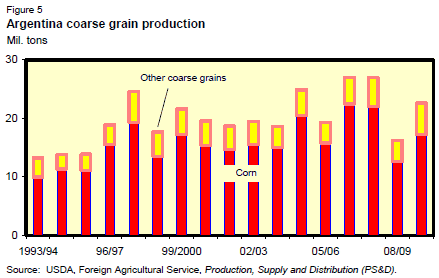
Global Coarse Grain Use Projected Up More Than Supplies
World coarse grain consumption for 2009/10 is increased 3.4 million tons this month, mostly due to US changes. However, foreign consumption is also up, boosted 1.0 million tons to 809.1 million. Feed use projected for Argentina is up 1.2 million tons to 7.4 million due to increased corn production. Barley feed use is reduced 0.3 million tons in Iran, and there are numerous smaller changes to projected 2009/10 coarse grain use.
Global coarse grain use is projected to increase this month by more than world supplies, resulting in reduced 2009/10 ending stocks. However, the entire reduction in global stocks is concentrated in the United States, with foreign coarse grain stocks projected 0.4 million tons higher at 130.8 million. Turkey’s barley ending stocks are up 0.5 million tons this month, based on revised use estimates. Australia’s sorghum stocks are up 0.2 million tons due to revised beginning stocks. These changes offset a 0.7-million-ton drop in Argentina’s corn stocks caused by reduced beginning stocks and strong demand, especially for exports. Other changes are smaller.
US Corn Export Prospects Reduced
World corn trade projected for 2009/10 (October-September) is unchanged this month at 84.9 million tons. While imports by Viet Nam and China are increased slightly, these changes are offset by reduced “unaccounted” trade.
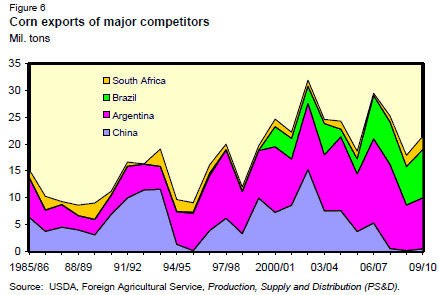
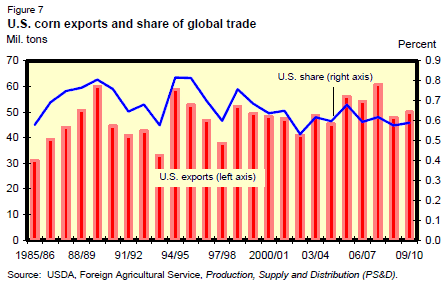
Argentina’s corn exports are increased 2.0 million tons this month to 9.5 million. The pace of export shipments from old-crop corn has exceeded earlier expectations, with export quota being made available that draw ending stocks to minimal levels. Moreover, increased new-crop production prospects support a continued strong export pace.
Increased competition from Argentina reduces prospects for US corn exports, down 2.0 million tons to 50.0 million for the 2009/10 October-September trade year. The pace of US corn exports during the early months of 2009/10 has been lackluster, with October-December 2009 Census exports of only 10.2 million tons, less than the previous year’s slow pace. Corn grain inspections for January 2010, at 3.5 million tons, increased from a year earlier, but were not at a pace to sustain the previous export projection. On 4 February 2010, outstanding export sales reached 11.9 million tons, large by historical standards, and up 2.4 million from a year earlier. So US corn exports are expected to strengthen in coming months, but not as much as would have occurred with less competition from Argentina. US corn exports for the September-August marketing year are lowered 50 million bushels to 2.0 billion.
US 2009/10 October-September trade year sorghum exports are increased 0.2 million tons this month to 3.8 million. The early-season export pace has slightly exceeded year-ago levels and as of 4 February 2010, outstanding sales are up nearly 60 per cent. Tight US sorghum supplies are expected to limit export growth. Projected sorghum imports for Mexico and Japan were raised slightly this month. US sorghum exports for the September-August marketing year are raised 10 million bushels to 150 million.
Changes to projected 2009/10 October-September global barley trade include reduced exports for the EU and Kazakhstan, partly offset by an increase in export prospects for Turkey.
Further Reading
| - | You can view the full report by clicking here. |
February 2010


